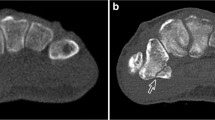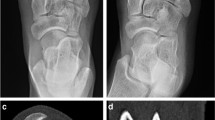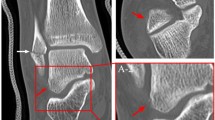Abstract
Objective
To investigate features of crush extremity fractures associated with massive earthquake on digital radiography (DR) and multidetector computed tomography (MDCT).
Materials and methods
Six hundred and twenty-three consecutive patients with clinically confirmed crush extremity fractures arising from the 2008 Sichuan earthquake were enrolled into our study. Six hundred and eleven patients with suggested extremity fractures underwent DR, and 12 patients with possible knee fractures underwent MDCT. Image data were retrospectively reviewed, with the focus on anatomic sites, numbers, and status of the fractures.
Results
Extremity fractures occurred in lower extremities in 428 patients, upper extremities in 151, and both lower and upper extremities in 44. Lower extremity fractures were more common than upper extremity fractures (P < 0.05), and the commonly involved bones were the tibia and fibula in 141 patients, femur in 102, tibia in 52, and fibula in 40. According to the numbers of bones involved, multiple bone fractures occurred in 336 patients and included lower extremity fractures in 231, upper extremity fractures in 61, and both lower and upper fractures in 44. Multiple fractures in lower extremities were seen more often than in upper extremities (P < 0.05). As for status of the extremity fractures, comminuted fractures occurred in 324 patients and included lower extremity fractures in 248, upper extremity fractures in 51, and both lower and upper extremity fractures in 25. Comminuted fractures were more common in lower extremities than in upper extremities (P < 0.05).
Conclusion
Multiple and comminuted fractures, predominantly in the lower extremities, could be considered as features of crush extremity fractures associated with the massive Sichuan earthquake.





Similar content being viewed by others
References
Demirkiran O, Dikmen Y, Utku T, Urkmez S. Crush syndrome patients after the Marmara earthquake. Emerg Med J. 2003;20:247–50.
Kuwagata Y, Oda J, Tanaka H, et al. Analysis of 2,702 traumatized patients in the 1995 Hanshin-Awaji earthquake. J Trauma. 1997;3:427–32.
Hussain P. Earthquake radiography. Radiogr Today. 1990;56:22–5.
Nakanishi K, Shimamoto S, Kishi M, et al. CT, MR imaging and muscle biopsy in severe crush injury. Acta Radiol. 1997;38:903–6.
Peek-Asa C, Kraus JF, Bourque LB, Vimalachandra D, Yu J, Abrams J. Fatal and hospitalized injuries resulting from the 1994 Northridge earthquake. Int J Epidemiol. 1998;27:459–65.
Bulut M, Fedakar R, Akkose S, Akgoz S, Ozguc H, Tokyay R. Medical experience of a university hospital in Turkey after the 1999 Marmara earthquake. Emerg Med J. 2005;22:494–8.
Emami MJ, Tavakoli AR, Alemzadeh H, et al. Strategies in evaluation and management of Bam earthquake victims. Prehosp Disaster Med. 2005;20:327–30.
Mahoney LE, Reutershan TP. Catastrophic disasters and the design of disaster medical care systems. Ann Emerg Med. 1987;16:1085–91.
Building Seismic Safety Council. Seismic considerations: health care facilities. Washington DC: Federal Emergency Management Agency Publication, 1990: FEMA 150.
Hamer OW, Sirlin CB, Strotzer M, et al. Chest radiography with a flat-panel detector: image quality with dose reduction after copper filtration. Radiology. 2005;237:691–700.
Behrman RH, Yasuda G. Effective dose in diagnostic radiology as a function of X-ray beam filtration for a constant exit dose and constant film density. Med Phys. 1998;25:780–90.
Shrimpton PC, Jones DG, Wall BF. The influence of tube filtration and potential on patient dose during X-ray examinations. Phys Med Biol. 1988;33:1205–12.
Rossi RP, Harnisch B, Hendee WR. Reduction of radiation exposure in radiography of the chest. Radiology. 1982;144:909–14.
Koedooder K, Venema HW. Filter materials for dose reduction in screen-film radiography. Phys Med Biol. 1986;31:585–600.
Ahn JM, El-Khoury GY. Occult fractures of extremities. Radiol Clin North Am. 2007;45:561–79.
Buckwalter KA, Farber JM. Application of multidetector CT in skeletal trauma. Semin Musculoskelet Radiol. 2004;8:147–56.
Mulvey JM, Awan SU, Qadri AA, Maqsood MA. Profile of injuries arising from the 2005 Kashmir earthquake: the first 72 h. Injury. 2008;39:554–60.
Sabzehchian M, Abolghasemi H, Radfar MH, Jonaidi-Jafari N, Ghasemzadeh H, Burkle FM Jr. Pediatric trauma at tertiary-level hospitals in the aftermath of the Bam, Iran Earthquake. Prehosp Disaster Med. 2006;21:336–9.
Author information
Authors and Affiliations
Corresponding author
Rights and permissions
About this article
Cite this article
Chen, Tw., Yang, Zg., Wang, Ql. et al. Crush extremity fractures associated with the 2008 Sichuan earthquake: anatomic sites, numbers and statuses evaluated with digital radiography and multidetector computed tomography. Skeletal Radiol 38, 1089–1097 (2009). https://doi.org/10.1007/s00256-009-0743-5
Received:
Revised:
Accepted:
Published:
Issue Date:
DOI: https://doi.org/10.1007/s00256-009-0743-5




